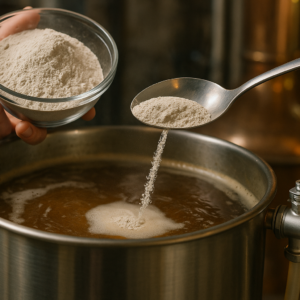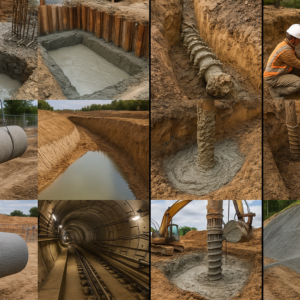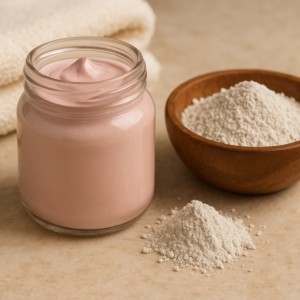If you’ve ever wondered how drillers manage to bore hundreds of feet into the ground without the hole collapsing, the answer often comes down to one material: bentonite. This naturally occurring clay has become the go-to solution for water well drilling operations around the world. Let’s break down what makes bentonite so special and how it keeps drilling projects on track.
Understanding Bentonite Clay
Bentonite is a type of clay formed from volcanic ash that settled millions of years ago. The name comes from Fort Benton, Wyoming, where large deposits were first identified. What sets this clay apart from others is its unique composition, primarily made up of a mineral called montmorillonite.
The magic happens when bentonite meets water. This clay can absorb several times its own weight in water, swelling up to 15 times its original dry volume. Think of it like a sponge, except much more powerful. When mixed with water, bentonite transforms into a thick, gel-like substance that drillers rely on for multiple purposes during well construction.
CMS Industries specializes in manufacturing different grades of this material, producing over 9,000 metric tons of bentonite powder monthly from their facilities in Gujarat. Their location near world-class ports makes them a major supplier for drilling operations across the globe.
The Role of Bentonite in Water Well Drilling
When you’re drilling a water well, you’re essentially creating a hole that wants to collapse. Loose soil, sand, and unstable rock formations all pose threats to the drilling process. Water well drilling bentonite solves this problem by creating what drillers call “drilling mud.”
Here’s how it works. As the drill bit penetrates deeper into the earth, drillers pump bentonite mixed with water down through the drill pipe. This mixture flows out through the drill bit and back up along the sides of the borehole, carrying rock cuttings and debris to the surface.
But that’s just the beginning. The bentonite mixture coats the walls of the borehole, forming a thin layer called a filter cake. This coating acts like wallpaper, sealing porous formations and preventing the hole from caving in. The filter cake is typically only a few millimeters thick but provides enough support to keep the borehole stable during drilling.
The process also lubricates the drill bit, reducing friction and heat that could damage equipment. This lubrication extends the life of drilling tools and makes the entire operation more cost-effective.
Key Properties That Make Bentonite Work
Swelling and Absorption
Sodium bentonite, the type most commonly used in drilling, has exceptional swelling properties. When hydrated, the clay platelets separate and expand, creating a colloidal suspension. This expansion creates the viscosity needed for the drilling fluid to function properly.
Thixotropic Behavior
Bentonite exhibits something called thixotropic behavior. This means the mixture becomes thinner and flows easily when stirred or pumped, but thickens and forms a gel when left still. This property is perfect for drilling because the mud flows freely during circulation but holds cuttings in suspension when pumping stops.
Thermal Stability
Deep wells can get hot. Bentonite maintains its properties even at elevated temperatures, making it suitable for wells that reach hundreds or thousands of feet below the surface.
Colloidal Properties
The tiny particles in bentonite remain suspended in water rather than settling out quickly. This colloidal nature keeps the drilling fluid consistent and effective throughout the drilling process.
How Bentonite Drilling Fluid is Prepared
Preparing water well drilling bentonite requires careful attention to mixing ratios and hydration time. Most drilling operations use a concentration between 5% and 8% bentonite by weight. Too little bentonite won’t provide adequate viscosity or borehole support. Too much creates an overly thick mixture that’s hard to pump and can damage formations.
The mixing process typically involves adding bentonite powder slowly to water while stirring continuously. This prevents clumps from forming. The mixture needs time to hydrate fully, usually between 30 minutes and several hours depending on the bentonite grade and water chemistry.
Water quality matters too. Fresh water works best for sodium bentonite. Hard water with high calcium or magnesium content can reduce the swelling properties of bentonite, requiring adjustments to the mix or the addition of other materials to improve performance.
Professional drillers test the drilling fluid regularly during operations, measuring properties like viscosity, density, and pH. These tests help them adjust the mixture as drilling conditions change with depth.
Curious which is more eco-friendly — calcium bentonite or paper bentonite? Read this blog to find out which one leads in sustainability!
The Drilling Process Step by Step
Let’s walk through how bentonite functions during an actual drilling operation.
Step 1: Initial Setup Drillers prepare the bentonite mixture in a mud pit or tank near the drilling rig. They mix the clay with water to achieve the desired consistency based on the expected soil conditions.
Step 2: Circulation Begins As drilling starts, pumps push the bentonite mixture down through the hollow drill pipe. The fluid exits through ports in the drill bit.
Step 3: Cuttings Removal The drilling fluid carries rock chips and soil cuttings up the outside of the drill pipe to the surface. The viscosity of the bentonite suspension keeps these particles from settling back down the hole.
Step 4: Borehole Stabilization While circulating, the bentonite coats the borehole walls, sealing porous zones and supporting loose formations. This filter cake builds up gradually as drilling progresses.
Step 5: Monitoring and Adjustment Drillers watch the returning fluid for changes in color, consistency, or volume. These changes indicate different geological formations or potential problems. They adjust the bentonite concentration as needed.
Step 6: Well Completion After reaching the target depth, the drilling fluid continues to protect the borehole while the well casing is installed. Once the well is complete, drillers remove most of the bentonite and develop the well to ensure clean water production.
Different Grades for Different Needs
Not all bentonite is created equal. Different drilling conditions require different specifications. CMS Industries produces multiple grades of bentonite powder and lumps to meet various drilling requirements.
API-grade bentonite meets specifications set by the American Petroleum Institute. This standard ensures consistent performance across different drilling applications. The specification requires a minimum apparent viscosity of 15 millipascal-seconds when 20 grams of bentonite is mixed in 350 milliliters of fresh water.
For water well drilling, the specific grade depends on factors like soil type, well depth, and water chemistry. Sandy formations typically require higher viscosity fluids, while clay-rich soils might need thinner mixtures.
Environmental Considerations
Bentonite is a natural clay mineral and generally considered environmentally safe. It doesn’t contain toxic chemicals or synthetic additives in its pure form. When wells are completed properly, the bentonite remaining in the formation poses minimal environmental risk.
That said, proper disposal of used drilling mud matters. Large volumes of mud containing rock cuttings need appropriate handling. Many jurisdictions require drillers to contain and dispose of drilling fluids according to local regulations.
The biodegradable nature of bentonite means it breaks down over time. In completed wells, any remaining bentonite in the formation gradually disperses or settles, having minimal long-term impact on groundwater quality.
Comparing Bentonite to Alternatives
While water well drilling bentonite remains the industry standard, some drillers use alternative materials or additives. Synthetic polymers can increase viscosity with less material, but they cost more and don’t provide the same sealing properties as bentonite.
Some operations combine bentonite with polymers to get benefits of both materials. The polymers enhance viscosity while the bentonite provides borehole stability and sealing.
Air drilling is another alternative that uses compressed air instead of fluid. This method works well in certain rock formations but can’t match bentonite’s versatility across different geological conditions.
For most water well drilling operations, especially in unconsolidated formations, bentonite remains the most reliable and cost-effective choice.
Common Challenges and Solutions
Even with quality bentonite, drillers sometimes face challenges. Hard water can reduce bentonite performance by interfering with the clay’s ability to swell. Adding soda ash to the water before mixing bentonite can soften the water and restore effectiveness.
Lost circulation occurs when drilling fluid disappears into highly porous or fractured formations instead of returning to the surface. Drillers address this by adding materials like cottonseed hulls or commercial lost circulation materials to the bentonite mixture. These materials plug the openings and restore circulation.
Clay-rich formations can contaminate the drilling fluid, changing its properties. Testing and adjusting the mixture helps maintain proper viscosity and performance.
Temperature extremes, either very cold or very hot, can affect bentonite behavior. In cold weather, warming the water before mixing helps achieve proper hydration. For deep, hot wells, special high-temperature bentonite grades maintain stability.
Choosing Quality Bentonite
The quality of bentonite directly affects drilling success. High-quality bentonite provides better viscosity, superior sealing properties, and more consistent performance. Poor quality material might save money upfront but can lead to borehole instability, equipment damage, and project delays.
When sourcing bentonite for water well drilling, look for suppliers who can provide technical specifications and quality certifications. ISO-certified manufacturers like CMS Industries follow strict quality control processes to ensure consistent product performance.
Consider the source of the bentonite. Different geological deposits produce clay with varying properties. Suppliers with access to premium deposits and proper processing facilities deliver more reliable products.
Looking Ahead
The drilling industry continues to refine bentonite applications. Research into nanoparticle-sized bentonite shows promise for creating more effective drilling fluids with improved properties. These advances could reduce the amount of material needed while maintaining or improving performance.
Environmental regulations are driving development of more sustainable drilling practices. This includes better recycling of drilling fluids and reduced waste generation. Quality bentonite supports these goals by performing reliably with minimal environmental impact.
As water demands grow globally, efficient well drilling becomes more important. Understanding and properly using bentonite helps drillers complete wells faster, safer, and more reliably.
Connect With Quality Bentonite Suppliers
Whether you’re planning a water well drilling project or need reliable bentonite supplies for ongoing operations, working with experienced manufacturers makes a difference. CMS Industries brings decades of expertise in bentonite production, with strategically located facilities designed to serve drilling operations worldwide. Their range of bentonite grades ensures you’ll find the right specification for your specific drilling conditions.
Ready to learn more about bentonite solutions for your drilling needs? Visit CMS Industries to explore their product offerings and technical support services.
Frequently Asked Questions
What type of bentonite is best for water well drilling?
Sodium bentonite is the preferred choice for most water well drilling applications. It swells more than calcium bentonite when mixed with water, creating better viscosity and sealing properties. The swelling action provides superior borehole stability and carries cuttings more effectively. Most drilling specifications call for sodium bentonite that meets API standards.
How much bentonite do you need to drill a water well?
The amount varies based on well depth, diameter, and soil conditions. A typical mix uses 5-8% bentonite by weight, meaning 5-8 pounds per 100 pounds of water. A 100-foot deep well with a 6-inch diameter might require 50-100 pounds of bentonite. Deeper wells or unstable formations need more material to maintain proper fluid properties throughout drilling.
Can bentonite contaminate drinking water wells?
When used properly, bentonite poses minimal risk to water quality. It’s a natural clay mineral without toxic chemicals. After well completion, drillers develop the well by pumping water to remove drilling fluids. Any remaining bentonite gradually disperses or settles in the formation. Proper well construction and development ensure bentonite doesn’t affect the water supply long-term.
How long does bentonite take to hydrate before drilling?
Bentonite typically needs 30 minutes to several hours for full hydration, depending on water temperature, mixing method, and bentonite grade. Warmer water speeds hydration. Proper mixing with continuous agitation prevents clumping and ensures complete hydration. Many drillers prepare bentonite the night before drilling to guarantee optimal performance. Testing viscosity before use confirms the mixture is ready.
What happens if you use too much bentonite in drilling fluid?
Excessive bentonite creates an overly thick mixture that’s difficult to pump and can damage the well formation. The high viscosity increases pump pressure, straining equipment and consuming more energy. Thick mud may also seal formations too tightly, reducing well yield after completion. Too much bentonite makes it harder to remove cuttings at the surface and can leave excessive residue in the completed well.







